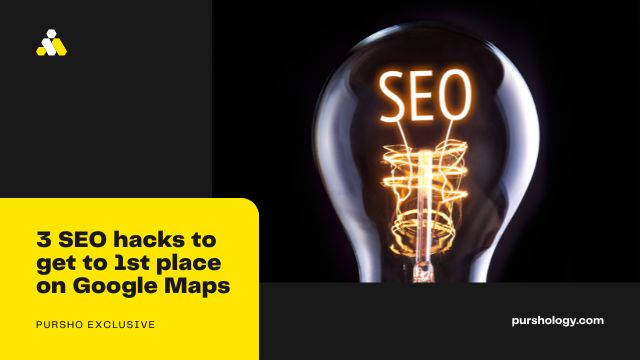The prized number one spot on Google Maps. Its power should not be underestimated, but how do you get there? Originally a simple virtual map to help you find your way, it has evolved to become a directory of local businesses and a way to discover new places. Features such as the ‘Explore’ tab convert users into devotees: easy scrolling of listings via just one platform so informed decisions can be made.
For businesses though, Google Maps is a powerful digital marketing tool capable of generating leads and sales without the need for huge amounts of ongoing work – minimum effort for maximum results.
- Helps searchers find your business
- People can easily and quickly contact you
- Drives traffic to your website and/or physical store
- Showcases images of your business
- Builds trust and authority in your brand
What information is found on Google Maps?
Google Maps is all about convenience. The listing is quick, informative, and accessible, the consumer is given all the information they need to make an informed decision. Remember, Google is all about user experience and providing the best quality information.
- Opening hours
- Address
- Service options
- Payment options
- Reviews and ratings
- Photos and images
- Business updates and posts
- Website link
- Click to call
- Click for directions
As with all aspects of a digital presence, SEO is key to getting to that number one spot, and Google Maps is no different – some Google Business Profile (previously known as Google My Business) SEO magic is required. There are numerous signals Google Maps use to rank your business but let’s pay attention to the ones that create the biggest impact over the shortest amount of time.
Step 1 to get to #1 on Google Maps
Your first step is to download GMB Everywhere to your Google Chrome browser. GMB Everywhere is a fantastic tool for local SEO. The competitor information it delivers is invaluable. Once downloaded, go to Google Maps and search for your business type. For example, digital agency Christchurch NZ. Get familiar with the data the extension provides – it’s amazing how many SEO opportunities you will spot simply from competitor analysis.
Step 2 to get to #1 on Google Maps
Your second step is to create your Google Business. Updating your business profile and making sure the information is correct is a priority. Inaccurate opening times, wrong payment methods, the incorrect postcode present unnecessary obstacles to people wanting to spend their money with you.
· Primary business category
Information gleaned from GMB Everywhere is also used to develop the best Google Business Profile SEO. The primary business category is most influential, but often defined without due diligence. It may seem like a no-brainer but go the extra mile and research which keywords are the best to use. For example, are you a law firm or is it a family law firm? You may find family law firm is a better option with more monthly searchers and less keyword difficulty. Link the website on the profile back to a landing page relevant to the primary business category you use. Using the law firm example, the website should open to the family law landing page (with keyword in page title) the rather than to the home page.
TIP: Use GMB Everywhere to see which category your competitors have selected (denoted by a star) and add them to your Google Business Profile. Google Maps SEO signals include additional categories.
· Google reviews
Reviews of your business play a crucial role in how the business is ranked by Google Maps. The number of positive reviews is obviously important, but so too are the words within the review. If customers use the targeted keywords within the review (e.g., family lawyer) this carries more clout. Email customers directly to leave a review and encourage them to use specific terms. You can send a link from the customer tab on your Google Business profile. Always respond to reviews – even the negative ones.
TIP: Revisit GMB Everywhere and take advantage of the Review Audit option for competitors. There’s a complete keyword analysis for you to use for your advantage!
Step 3 to get to #1 on Google Maps
What is a backlink in SEO? A backlink is a link from a website that is not your own and is a ranking signal extolled by search engines. The quality and quantity of the backlink helps you to rank higher in search engine results pages, and Google Maps too. Gain backlinks from local businesses and organisations, it shows Google you are a valuable player in the local community.
How do you get SEO backlinks to a website?
Established contacts: If you have completed work for government bodies, local schools, or other respected businesses or outfits, ask them for a link back to your website. Provide them with content and where you see it fitting on their website – give them the page, paragraph and content you would ideally like adding, and make the process as easy as possible for them.
Create a guide: Create a guide for your ideal customer in your broad area. The guide should contain other local complementing businesses related to your niche. Choose businesses with good reputations and always check out how many followers they have. For example, if you run a hostel, your guide could be ‘The 10 best things Backpackers do in Christchurch’ and include street art, day tours, Sumner Beach, surf hire etc. – this works very well with Instagram and Facebook. Once you have created the guide, share it with the included businesses to leverage the full power of social media.
Create great content: Research from BuzzSumo involved the study of 912 blog posts and articles. It found that 94% had zero backlinks – but the good news is they compiled a list of the most popular backlink content formats:
- Why posts
- What posts
- Infographics
- Video posts
- General posts
- How-to posts
- List posts
Broken backlink strategy: Most outreach emails are singular requests for webmasters to publish an article or blog post. However, a broken backlink strategy turns it on its head. Use Check My Links (another free Chrome extension) to identify websites’ broken links, contact the Webmaster, give the heads up about the broken link and provide your replacement link. Mutual back scratching in all its glory!
The 1st place on Google Maps is a coveted and profitable spot for those who have embraced local SEO. Establishing authority, reputation and expertise online are similar to that in the real world. If you continue to answer customers’ queries, deliver quality products and services, embrace customer care, be active in your local community and share great feedback – you will enjoy the rewards from Google and customers alike.




